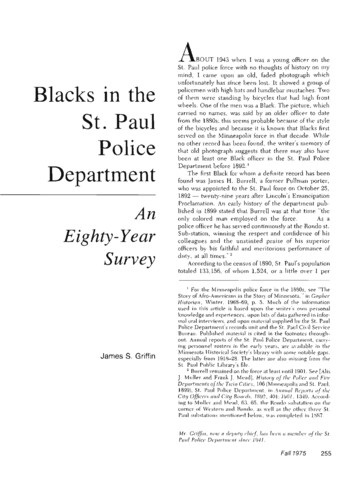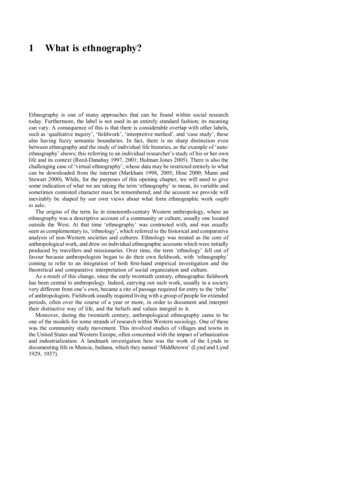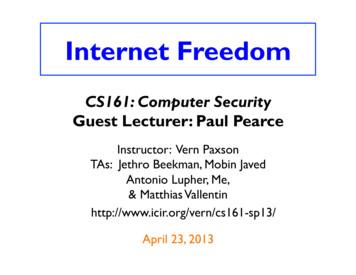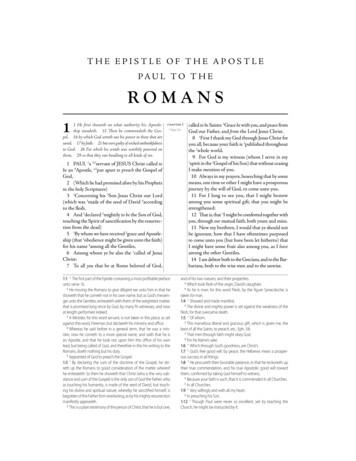
Transcription
ABlacks in theSt. PaulPoliceDepartmentAnEighty-YearSurveyJames S. GriffinL B O U T 1943 when I was a young officer on theSt. Paul police force with no thoughts of history on mymind, I came upon an old, faded photograph xvhichunfortunately has since been lost. It showed a group ofpolicemen xvith high hats and handlebar mustaches. Twoof them xvere standing by bicycles that had high frontwheels. One of the men was a Black. The picture, whichcarried no names, was said by an older officer to datefrom the f880s; this seems probable because of the styleof the bicycles and because it is known that Blacks firstserved on the Minneapolis force in that decade. W h d eno other record has been found, tbe writer's memory ofthat old photograph suggests that there may also havebeen at least one Black officer in the St. Paul PoliceDepartment before 1892.'The first Black for whom a definite record has beenfound was James H. Burrell, a former Pullman porter,who was appointed to the St. Paul force on October 25,1892 — twent '-nine years after Lincoln's EmancipationProclamation. An early history of the department published in f899 stated that Burrell was at that time "theonly colored man employed on tbe force.As apolice officer he has served continuously at the Rondo st.Sub-station, winning the respect and confidence of hiscolleagues and the unstinted praise of his superiorofficers by his faithful and meritorious performance ofduty, at all times. " According to the census of 1890, St. Paul's populationtotaled 133,156, of whom 1,524, or a little over 1 per' For the Minneapolis police force in the 1880s, see ""TheStory of Afro-Americans in the Story of Minnesota, " in GopherHistorian, Winter, 1968-69, p. 5. Much of the informationused in this article is based upon the xx'iiter's oxx'ii personalknoxvledge and experiences, upon bits of data gathered in informal oral interviews, and upon material supplied by the St. PaulPolice Departmenf s records unit and the St. Paul Cix d ServiceBureau. Published material is cited in the footnotes throughout. Annual reports of the St. Paul Police Department, carrying personnel rosters in the early years, are ax'ailable in theMinnesota Historical Society's library with some notafile gaps,especially from 1918-28. The latter are also missing from theSt. Paul Public Librarys file. Burrell remained on the force at least until f 901. See [AlixJ. Muller and Frank J, Mead], History of the Police and FireDepartments of the Twin Cities, 106 (Minneapolis and St, Paul,1899); St, Paul Police Department, in Annual Rcpoiis of theCity Officers and City Boards. 1892, 401; 1901, 1349, According to Muller and Mead, 63, 65, the Rondo substation on thecorner of Western and Rondo, as xvell as the other three St,Paul substations mentioned below, was completed in 1887,Mr. Griffin, noiv a deputy chief, has been a member of the St.Paul Police Departnwnt since 1941.Fall 1975255
cent, were Black. All males in the state had the right tox'ote, and no segregated schools had existed in St. Paulsince 1869. It is not surprising that Officer Burrell hadb e e n employed as a Pullman porter, for during thisperiod near the turn of the centurx' many Black menworked as laborers, or bootblacks, or as coachmen, waiters, and porters on the railroads that served the city. A fexv Blacks owned businesses. Harry Shepherd wasa successful p h o t o g r a p h e r , G e o r g e B. Lowe had apicture-framing establishment, and many of St. Paul'sbarbershops then and later were owned and operated byBlacks. Some like John Quincy Adams occupied whitecoffar jobs before 1900. From 1887 to 1922 Adams wasthe editor of the Western Appeal, St. Paul's Black newspaper, and he was also appointed bailiff and acting clerkof municipal court by Mayor Frank B. Dorau in 1896.Other Black professionals of this period included Bessieand Minnie Farr, who were probably St. Paul's firstBlack schoolteachers; Dr. Valdo D. Turner, the city'sfirst Black physician; Frederick L. McChee, its firstBlack attorney; and William F. (Billy) Williams, who wasfirst appointed executive aide in the governor's office in1904 and remained in that post until 1957."'Officer Burrell blazed a trail on the police force that afew others followed. In 1896 Louis (or Lewis) Liverpool, "formerly a hackinan, " started work as a janitor atthe Central Station, then located on West Third Street.At this time the country was in a period of economicdepression, and St. Paul patrolmen's salaries xvere reduced in September, 1896, from 72.50 to 70.00 amonth. W h e n Liverpool later became a patrolman, hewas assigned to a beat in the Rice Street area, which xvasregarded as a "tough" section of the city where gangs ofyouths gathered on street corners and terrorized citizens. They were also known to shoot or beat up policeofficers.''Many stories have been handed down orally aboutLiverpool, who is said to have gained tbe lasting reputation of being able to handle all comers on his beat. Onestory goes that, because of bis fighting prowess, Liverpool was asked to go a few rounds in a boxing exhibitionwith an unknown man. Purposely no one told him whothe fellow was; it was to be a big joke. During the firsttwo rounds, Liverpool gave the fellow a real going over,but at the end of the second round somebody told him hewas b o x i n g w i t h J o h n L. S u l l i v a n , f o r m e r w o r l dheavyweight champion. Liverpool then lost his confidence, and Sullivan was able to handle him with ease.After Liverpool, the next Black officer seems to havebeen James H. Loomis, who became a patrolman assigned to municipal court as a bailiff in 1900. Five yearslater the St. Paul force was expanded when 40 men wereadded, making a total of 217 employeees, 161 of whomwere in the foot patrol. Among them was Black patrolman Charles R. Grisim, who left the department two256Minnesota Historyyears later and moved to Spokane, Washington. AfterGrisim's departure in 1907, at least four more Blackofficers joined the force: Abraham L. Yeiser from 1908 to1912, w h e n he transferred to t h e fire d e p a r t m e n t ;William P. Lewis in 1911; and Joseph C. Black andJames T. Quarles in I9I2. Joseph Black became the firstBlack officer to hold the rank of detective when he waspromoted in 1914 — the year St. Paul adopted CivflService for all city employees.''Marquette Smith, better known as Mark Smith, along-time white officer now deceased, once asked me if Ihad ever heard of Quarles, who, he said, had been a heroof his when he was a youngster growing up in St. Paul. Ireplied that I knew Quarles had b e e n a member of thedepartment and that my step-grandfather had been apaflbearer at his funeral. This remote connection seemedto please Smith, and he told me that he had becomeacquainted with Quarles before World War I when the United States Cewsus, 1890, Population, 1:389, 539;Gopher Historian, Winter, 1968-69, p. 8, 11, 29. [Muller and Mead], History of Police and Fire Departments, 153; Gopher Historian, Winter, 1968-69, p. 8, 10,18-20, 22; David V. Taylor, "'John Quincy Adams: St. PaulEditor and Black Leader, " in Minnesota History, 43:283-96(Winter, 1973). The first Black xvas also elected to the legislature in this period. He xvas J. Frank Wheaton, a Minneapolislawyer who served in the House of Representatives in 1899;Gopher Historian, 19. [Muller and Mead], History of Police and Fire Departments, 71, 75, 81, 83, 126. Louis (or Lewis) Liverpool appearedas a janitor on the personnel rosters of the department from1896 through 1899; see Chief of Police, in Annual Reports ofCity Officers, 1896, 786; 1898, 947; 1899, 749. The city directory listed him as a special policeman in 1903 and again in 1913.In between these dates he apparently worked as a watchmanand operated a hand laundry . In 1914 he xvent into the expressbusiness. See Sf. Paul City Directory, 1903-14.''The Minneapolis Tribune of June 16, 1970, erroneouslyreported that a man in the Hennepin County sherifi 's office in1970 xvas the first Black detective in the history of Minnesota.Photos of Yeiser and Lewis and some information on Grisimmay be found in Maurice E. Doran, History of the Saint PaulPolice Department, 70, 82, 120, 122 ([St, Paul, 1912]). St. PaulCity Directory, 1908, recorded Grisim's move to Washington.See also Board of Police, in Annual Reports of City Officers,1900, 780 (Loomis); i.905, 737, 7.54 (Grisim); 1908, 401 (Yeiser);Board of Police, Annual Reports, 1911, 68 (Lewis); 1912, 82, 92(Black and Quarles); 1,914, 5 (Black), The latter are listed asdetectixes in St. Paul City Directory, 1913, 1914, On Yeiser,see also St, Paul Board of Fire Commissioners, Annual Report,1913, 68, For the beginnings of Cixil Serxice, see St, PaulBureau ot Cixil Serxice, .\nnu(d Reports, 1915, 7, 30.Exen with the help of photographs, it has been impossibleto establish the identities of all the Black officers, and at leasttxvo others max' have served on the force by 1912, The xvriterwas told o( a Black patrolman named William Joyce, and of.\iidrew Jackson, xvho began as a janitor in the police department on June 9, 1912, and, according to Cixil Service records,transferred to administration in f930, although I have beentold he spent some time as a patrolman; see Board of Police, inAnnual Reports, 1912, 66; i929, 24,
WILLIAM F. WILSONJOSEPH C. BLACKofficer was walking a beat in the vicinity of Acker andJackson streets near Smith's h o m e . Smith said thatQuarles was well known in the neighborhood and hadthe reputation of being a two-fisted, tough, and aggressive officer, who indulged in a little libation while onduty.Mark recalled that he once saw Quarles coming out ofa saloon at the intersection of Acker and Jackson andstriding off up the street, staggering a bit as he went.Several young toughs saw Quarles and began to harass' Quarles is erroneously listed in later departmental reportsamong those officers "killed or who died from injuries receivedwhile in the performance of their duty." See, for example.Bureau of Police, Annual Reports, 1929, 56, On his death, seeSt. Paul Pioneer Press, March 29, f920, p. 1. At the time of hisdeath, Quarles seems to have been working as a plain-clothesdetectix'e, although there is no record of his formal promotionto this rank.* On Wilson, see Bureau of Police, Annual Report, 1914,11; St. Paid Pioneer Pre.ss, February 7, 1923, p. 1.him. Smith said he realized immediately that the youthsm u s t b e s t r a n g e r s in t h e n e i g h b o r h o o d b e c a u s eeveryone who lived there knew Officer Quarles was not aman to be trifled with. The youths told Quarles that "St.Paul must be in a sorry state to hire a nigger policeman.Smith reported that it took Quarles about three minutesto put all three flat on their backs and have someone inthe saloon call the patrol wagon. Quarles remained withthe department until his death on March 28, 1920."T H E FIRST Black officer to be appointed after the adoption of city-wide Civil Serxice was William F. \\'ilson,who was assigned to the Prior substation as a chauffeuron October 14, 1914. Wilson also has the distinction ofbeing the only St. Paul Black officer to lose his life in theline of duty. I le died in a fatal auto accident at Charlesand Snelling while an.swering a police call on February 6,1923."Fred E. Talbert and James A. Mitcbefl, xvho wereappointed in 1917, were the next to be added under theFall 1975257
RONDOturySTREET substationaround the turn of the cen-Cixil Service system. Talbert and Mitchell also set tworecords that stand in the St. Paul department's files tothis day. Talbert was the only Black ever to serve as amotorcycle officer, a choice assignment he received in1922. Mitchell started as a detective without ever holding the rank of patrolman. (After 1918 such direct appointments were no longer possible; since that time ithas been required that all officers on tbe St. Paul forcebegin their careers as patrolmen.)Mitchell served in the department until August 22,1939. H e worked on many difficult cases, including thefamous unsolved Ruth Munson murder in the 1930s, andwas known as a courageous detective. On one occasionhe and two other members of the force went to an upstairs address on Rondo Avenue to arrest an allegedm u r d e r suspect. W h e n the officers knocked on the doorand identified themselves, several shots were firedthrough the door, narrowly missing the men. The suspect then flung open the door, ran out, and j u m p e ddown a flight of stairs in an effort to escape. Mitchellgave chase and singlehandedly apprehended the man anhour or so later. Detective Mitchell was frequently detailed to burglary "plants, " a particularly nasty assignment that couldsometimes last more than a year for Black officers. Insuch cases the officer waits in a business place that islikely to be burglarized, watching for any attempt at illegal entry. A burglary plant is usually carried out atnight. In winter, the buildings might be u n h e a l e d ,infested by rats, and lonely and uncomfortable. Suchassignments are still unpopular among members of theforce. In Mitchell's day Black detectives and patrolmend r e w more than their share of plants and the mostundesirable and toughest beats.By the time these men joined the d e p a r t m e n t ,downtown St. Paul had at least a few Black-owned busi-258Minnesota HistoryCHARLES J. BRIGHTROBERT WILLIAMSness establishments. Probably the best known were Curley (Noah C.) Campbefl's hotel and saloon at 122 EastThird Street, and the Up-Town Sanitary Shop, a drycleaning and shoe-repairing firm at 339 Wabasha Streetopposite the courthouse. The latter advertised "FrenchDry Cleaning" in 1919 and reported " W e Call and Deliver."'"In those days after the turn of the century most cafesand saloons would serve Blacks, but hotels and barbershops would not. W h e n a national Black organizationknown as the Pan-African Council held a conx'ention inSt. Paul in 1 9 0 2 , " many owners of public accommodations objected on the grounds that it would bring toomany Blacks to the city and create problems. The convention met, however, in the senate chambers of the oldState Capitol, and cafe and restaurant owners who werewilling to serve those who attended went on record byplacing a card of a certain color in the windows of theirestablishments.AFTER W O R L D WAR I, with good times and ampleemployment in St. Paul, at least five more Blacks joinedthe force: Milton Noble Pryor in 1919, Charles J. Bright,William H. Gaston, and Robert Wdliams in 1920, and Ruth Munson died inysteriousb' in a fire in St. Paul sAberdeen Hotel on December 9, 1937. See Sf. Paul PioneerPress, December 10, 1937, p. 1." St. Paul City Directory, 1911-14, listed Campbell's atthis address. The Up-Toxvn advertised in St. Paul Police Benevolent Association, Souvenir Book, 1919, 70 ([St. Paul,1919]), in which photos may be found of Joseph Black, 21,Mitchell, 23, and Quarles and Jackson, 32, After the repeal ofProhibition in 1933, James Williams' bar at 560 St. AnthonyAvenue max' xvell haxe been the most successful Black businessin the history of St. Paul." On the convention, see Taylor, in Minnesota History,43:295.
James H o m e r Coins in 1921.' The writer was later acquainted with some of these men. Williams was still onthe force when I first joined in 1941, and he gave mevaluable advice.Homer Coins is r e m e m b e r e d as a popular and wellliked officer of the 1920s. Nate Bomberg, a veteranpolice reporter on the St. Paul Pioneer Press, providedthe author with t h e following reminiscence of thatperiod: " W h e n I started out as a police reporter in thelate twenties, " Bomberg wrote, "there were four substations in St. Paul. They were Rondo [at] Rondo andWestern; Ducas [at] South Robert and Delos; Prior [at]Prior and Oakley; and Margaret [at] Margaret and Cable.' "These sub-stations were little corrupt governmentsof their own with each having their own cells, bookings,wagon crews and a touring car manned by detectives andby anyone else who was around. All were in charge ofcaptains w h o w e r e t h e ' K i n g s ' in t h e i r d i s t r i c t s .These stations were abandoned when the police weremotorized and the police radio went into effect [about1930]."Of all the personnel at these stations, one man always stands out in my mind. H e was Homer Coins of theRondo sub-station. He was a big man, six foot one or txvoand xveighed about two Imndred pounds and all muscle.He served as jailor, desk officer, chauffeur for Captain[Charles H.] Gates, bodyguard and general investigator.' Before joining the force Pryor and Goins were waiters.Bright and WilHams xvere porters, and Gaston xvas a laborer.See Sf. Paul City Directory, 1919, 1920.13 Nate Bomberg to James S. Griffin, 1973. All thesesubstations were for sale in 1929. At that time a foot patrofman"s salary was 1,53.20 a month, and the department had atotal of 344 employees of whom 198 were patrolmen, accordingto corrected totals inked into its Annua/ Report in the St. PaulPublic Library. The new police districts established at thattime were at University and St. Albans, 480 Prior, 779 Margaret, and 402 South Robert. In 1929 the Captain Gates mentioned below was in charge of the South Robert district, whfleCaptain Charles H. Cerber commanded the one at Universityand St. Albans, where Goins was then employed as a patrolmandetailed as jailer. It is possible that Mr. Bomberg confused thetwo captains with the same first name. See Annual Reports,1929, 5, 7, .32, 37, 42, 46.'" Goins did not always escape un.scathed himself Althoughno details have been found, he is listed as having been injuredon duty and lost eleven days of work in Bureau of Police,Annual Reports, 1930, 20,'''' On the new building, see Police Department, AnnualReports, 1930, [1], Veterans' preference laws, frequentlyamended, go Isack at least to f907 in Minnesota, In someperiods in cities of the first class they permitted absolute preference for entrance after receiving a passing grade on CivilService examinations or prohibited a veteran's removal fromemployment except for "'incompetency or misconduct shownafter a hearing," See Minncsoffl Statutes, 1927, p, 979; 1945, p,1643; 1957, p, 1848; Minnesota Session Laws, 1957, p, 1005,He was used on all 'heavy' cases. In my tiook. Homerwas a first class gentleman at all times, never an aggressor, but woe to anyone who aroused him or got out ofline. W h e n 'downtown' had a big raid to arrest a numberof'heavies,' such as stickup men or yeggs (safe men) andthere were doors to crash. H o m e r xvas always called. H ewas the first one to break down a door and also the firstone to go in. H e never lagged behind. Among the"heavies' of that day. Homer was respected by them andno one ever tried any "monkey business' with him because they knew they would come out second best. Onone occasion he had to crash in a door and several suspects j u m p e d him. He subdued them and brought themin. They were treated for broken ribs and later Homerbought them chicken and ribs to show there were nobard feelings."'''In 1925 a total of eight Black officers was serving inthe Police Department. This total gave St. Paulthe distinction of having more Blacks on its force percapita than any other city in the United States at thattime. During the 1920s, however, their fortunes in thedepartment made an about-face as tbe administrationbegan systematically to eliminate them. As they died,retired, or were forced to resign, no replacements weremade. One commissioner of public safety went on recordthat no more Blacks would serve as policemen whde hewas in office. So during the sixteen years from Coins'appointment in 1921 untd 1937, when Robert L. Turpinjoined the force, not a single Black officer was hired.The employment picture for Blacks generally hit anall-time low in the 1930s. With the Great Depression infufl swing and jobs scarce. Blacks were usually the last tobe hired and the first to be fired. After the
Police Departmen sf records unit and the St. Pau Cilx d Service Bureau. Published material is cited in the footnotes through out. Annual reports of the St. Paul Police Department, carry ing personnel rosters in the early years, are ax'ailable in the Minnesota Historical Society's l











